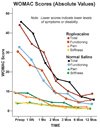Health-related quality of life after tricompartment knee arthroplasty with and without an extended-duration continuous femoral nerve block: a prospective, 1-year follow-up of a randomized, triple-masked, placebo-controlled study
- PMID: 19299806
- PMCID: PMC2701222
- DOI: 10.1213/ane.0b013e3181964937
Health-related quality of life after tricompartment knee arthroplasty with and without an extended-duration continuous femoral nerve block: a prospective, 1-year follow-up of a randomized, triple-masked, placebo-controlled study
Abstract
Background: We previously provided evidence that extending an overnight continuous femoral nerve block to 4 days after tricompartment knee arthroplasty (TKA) provides clear benefits during the perineural infusion in the immediate postoperative period. However, it remains unknown if the extended infusion improves subsequent health-related quality of life between 7 days and 12 mo.
Methods: Patients undergoing TKA received a femoral perineural infusion of ropivacaine 0.2% from surgery until the following morning, at which time patients were randomized to either continue perineural ropivacaine (n = 25) or normal saline (n = 25) in a double-masked fashion. Patients were discharged with their catheter and a portable infusion pump, and catheters were removed on postoperative day 4. Health-related quality of life was measured using the Western Ontario and McMaster Universities Osteoarthritis (WOMAC) Index preoperatively and then at 7 days, as well as 1, 2, 3, 6, and 12 mo after surgery. The WOMAC evaluates three dimensions of health-related quality of life: pain, stiffness, and physical functional disability. For inclusion in the analysis, we required a minimum of 4 of the 6 time points, including day 7 and at least 2 of mo 3, 6, and 12.
Results: The two treatment groups had similar WOMAC scores for the mean area under the curve calculations (point estimate for the difference in mean area under the curve for the two groups [overnight infusion group-extended infusion group] = 1.2, 95% confidence interval: -5.6 to +8.0; P = 0.72) and at all individual time points (P > 0.05).
Conclusions: We found no evidence that extending an overnight continuous femoral nerve block to 4 days improves (or worsens) subsequent health-related quality of life between 7 days and 12 mo after TKA. (ClinicalTrials.gov number, NCT00135889.).
Conflict of interest statement
Figures


References
-
- March LM, Cross MJ, Lapsley H, Brnabic AJ, Tribe KL, Bachmeier CJ, Courtenay BG, Brooks PM. Outcomes after hip or knee replacement surgery for osteoarthritis. A prospective cohort study comparing patients' quality of life before and after surgery with age-related population norms. Med J Aust. 1999;171:235–238. - PubMed
-
- Walsh M, Woodhouse LJ, Thomas SG, Finch E. Physical impairments and functional limitations: a comparison of individuals 1 year after total knee arthroplasty with control subjects. Phys.Ther. 1998;78:248–258. - PubMed
-
- Jevsevar DS, Riley PO, Hodge WA, Krebs DE. Knee kinematics and kinetics during locomotor activities of daily living in subjects with knee arthroplasty and in healthy control subjects. Phys.Ther. 1993;73:229–239. - PubMed
-
- Ryu J, Saito S, Yamamoto K, Sano S. Factors influencing the postoperative range of motion in total knee arthroplasty. Bull.Hosp.Jt.Dis. 1993;53:35–40. - PubMed
Publication types
MeSH terms
Substances
Associated data
Grants and funding
LinkOut - more resources
Full Text Sources
Medical

